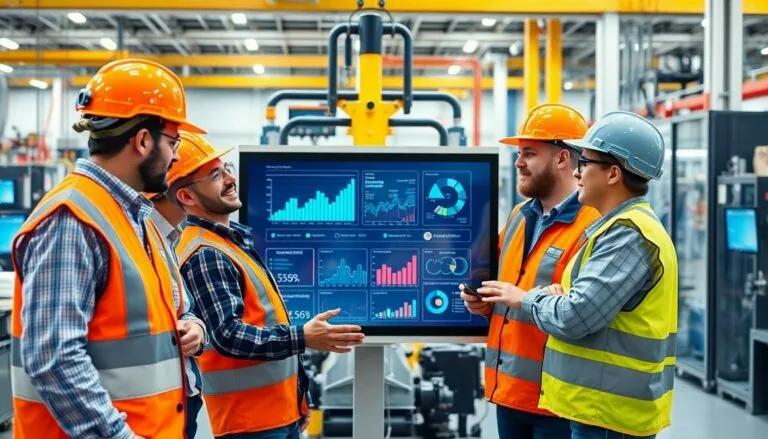Table of Contents
ToggleImagine a world where your fridge knows when you’re out of milk and orders more before you even realize it. Now, throw in some blockchain magic, and you’ve got a recipe for the future that’s not just smart but secure. Blockchain IoT is the dynamic duo transforming everyday devices into savvy, interconnected systems that communicate seamlessly and safely.
Overview of Blockchain IoT
Blockchain IoT combines blockchain technology with Internet of Things devices, creating a robust framework for secure data exchange. This integration allows smart devices to operate autonomously while maintaining data integrity and security. For instance, a smart thermostat can regulate energy use by communicating with other devices, optimizing energy consumption without human intervention.
Data privacy represents one of the crucial advantages of Blockchain IoT. Each device interacts on a secure network, ensuring that sensitive information remains protected. When a smart lock receives an authorization request, blockchain verifies the user’s identity without exposing personal data.
Scalability also plays a vital role in this technological landscape. As the number of connected devices surges, integrating blockchain facilitates efficient data management. This framework enables devices to record transactions in real-time while ensuring minimal latency.
Interoperability enhances collaboration among devices from different manufacturers. Standard protocols on a blockchain network allow devices to communicate seamlessly. A diverse range of applications, such as supply chain management, healthcare monitoring, and smart cities, benefits from this capability.
Efficiency in operations improves significantly with Blockchain IoT. Devices can execute transactions autonomously, reducing the need for intermediaries. A smart grid can dynamically assess energy distribution and make decisions based on real-time data, ensuring optimized resource allocation.
Furthermore, transparency in transactions fosters trust among users and devices alike. Every transaction recorded on the blockchain provides an immutable history, making it easier to track and verify actions. Devices can collaborate while remaining accountable, which is essential in scenarios such as automated vehicle communication.
Blockchain IoT holds transformative potential across various industries. By enhancing security, scalability, interoperability, efficiency, and transparency, it sets the foundation for a more connected and secure future.
Key Benefits of Blockchain IoT

Blockchain IoT merges two groundbreaking technologies, offering several advantages that redefine operations across industries.
Enhanced Security
Enhanced security represents a core benefit of Blockchain IoT. Devices connect through encrypted channels, significantly reducing risks of cyber attacks. Data remains immutable once recorded on the blockchain, making unauthorized modifications nearly impossible. Users benefit from robust authentication mechanisms, ensuring only authorized devices can access sensitive information. This framework not only protects personal data but also strengthens the overall integrity of interconnected systems. Companies can implement these security measures effectively, leading to greater confidence in IoT deployments.
Improved Transparency
Improved transparency serves as a crucial advantage of integrating blockchain with IoT. Every transaction receives a timestamp and a unique identifier, creating a comprehensive audit trail. Stakeholders can track device interactions and transactions in real-time, fostering accountability. Misleading information becomes less likely, as all data is verifiable on the blockchain. Companies can assure customers of ethical practices, especially in sectors like supply chain management. Increased transparency encourages trust among consumers and businesses alike, making operations more reliable.
Increased Efficiency
Increased efficiency stands out as an essential benefit in Blockchain IoT implementations. Autonomous devices execute transactions without human intervention, streamlining workflows. Automation significantly cuts down processing times, allowing companies to respond swiftly to market demands. Resources become optimally allocated as devices communicate seamlessly, minimizing delays. Organizations can reap substantial cost savings through reduced need for intermediaries. Enhanced efficiency not only boosts productivity but also supports rapid scaling as the network grows, making it easier to manage connected devices effectively.
Challenges Facing Blockchain IoT
Blockchain IoT faces several challenges that impede its widespread adoption. Two significant areas of concern include scalability issues and interoperability concerns.
Scalability Issues
Scalability represents a critical hurdle for Blockchain IoT. High transaction volumes can overwhelm networks, especially as the number of connected devices expands. Each transaction, requiring confirmation from multiple nodes, can lead to delays and increased costs. Real-time applications, like autonomous vehicles, need instant processing to function effectively. The existing blockchain infrastructure often struggles to handle these demands, leading to potential bottlenecks. Solutions like Layer 2 protocols or sharding may help in addressing scalability by distributing loads more efficiently. Innovators must prioritize these strategies to ensure seamless operation of IoT devices.
Interoperability Concerns
Interoperability poses another significant challenge for Blockchain IoT. Diverse manufacturers create smart devices using various standards, making communication between them complex. Inconsistent protocols inhibit seamless interactions, which limits the technology’s effectiveness across different ecosystems. For instance, a smart thermostat may fail to integrate with a security system from another provider. Ensuring compatibility requires standardized frameworks that allow devices to work harmoniously. Industry collaboration becomes crucial for developing these standards. Solutions that enhance interoperability will facilitate broader adoption and unlock the potential of Blockchain IoT applications.
Real-World Applications of Blockchain IoT
Blockchain IoT finds applications across various industries, transforming operations and enhancing efficiencies.
Supply Chain Management
Supply chain management benefits significantly from Blockchain IoT. It enables real-time tracking of goods, ensuring transparency at every stage. Devices monitor shipments autonomously, recording data on the blockchain for an immutable record. This approach simplifies inventory management by providing accurate, timely information. Additionally, stakeholders access real-time updates, enhancing trust among parties involved. Such transparency reduces delays and enhances efficiency, leading to fewer errors and lower operational costs.
Smart Cities
Smart cities leverage Blockchain IoT to enhance urban living experiences. Connected devices throughout the city gather data in real-time, optimizing traffic management and reducing congestion. Sensors monitor public transportation systems, providing updates that inform citizens about delays or schedule changes. Moreover, energy management systems use data to distribute resources efficiently, lowering energy costs. Security benefits as well, with enhanced surveillance systems that autonomously report suspicious activity, fostering safer communities. Overall, Blockchain IoT promotes a more sustainable and efficient urban environment.
Healthcare Innovations
Innovations in healthcare emerge from the integration of Blockchain IoT. Patient data remains secure while enabling seamless sharing among medical professionals. Devices track medication usage, preventing errors and ensuring compliance. Telehealth solutions become more reliable, as encrypted communications protect sensitive information. Furthermore, real-time monitoring of patient vital signs leads to faster response times in emergencies. Blockchain IoT enhances traceability of medical supplies, reducing counterfeit risks and ensuring quality. The overall transformation leads to improved patient outcomes and efficient healthcare delivery.
Future Trends in Blockchain IoT
Emerging trends in Blockchain IoT signal transformative changes across various industries. These advancements leverage cutting-edge technologies to enhance interconnected environments.
Integration with AI and Machine Learning
Integration of AI and machine learning with Blockchain IoT drives smarter device interactions. Devices equipped with AI analyze data patterns and improve decision-making processes. This collaboration enables predictive maintenance, minimizing downtime for critical machinery and enhancing operational efficiency. When combined, AI’s real-time data processing capabilities benefit from blockchain’s secure data exchange, fostering trust among multiple stakeholders. Moreover, autonomous systems can utilize these insights for optimizing resource allocation, resulting in significant cost savings.
Expansion of Decentralized Networks
Expansion of decentralized networks reshapes the landscape of Blockchain IoT. An increase in decentralization enables more resilient and efficient networks that reduce single points of failure. Organizations benefit from enhanced security, as decentralized nodes distribute data across multiple locations. This architecture facilitates collaboration among diverse participants, promoting interoperability among various devices. Furthermore, decentralized networks support faster, transparent transactions, essential for real-time applications, particularly in industries such as supply chain and logistics. As these networks grow, they will pave the way for broader adoption of Blockchain IoT solutions globally.
The integration of blockchain technology with IoT is set to revolutionize how devices interact and operate. By enhancing security and efficiency, Blockchain IoT paves the way for a future where smart devices can autonomously manage tasks while maintaining data integrity.
As industries adopt this technology, the potential for improved transparency and reduced operational costs becomes increasingly evident. While challenges like scalability and interoperability remain, ongoing advancements promise to address these issues.
With the rise of decentralized networks and AI integration, Blockchain IoT is not just a trend but a transformative force that will redefine connectivity and operational excellence across various sectors. The future looks bright as these innovations continue to unfold.







